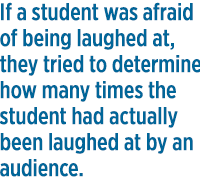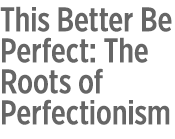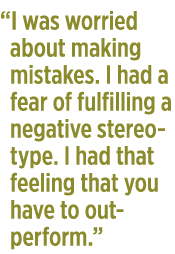

The dark underbelly of perfectionism and its crippling side effects can take a significant toll on the human mind, says psychology professor Patricia DiBartolo. Understanding the many dimensions of perfectionism and its resulting pathologies has been a key focus of her decades-long research.
/ Published May 26, 2016
When Vincent Van Gogh finished Starry Night, he wrote to his brother Theo that his iconic painting was “not even a little good.”
Psychology professor Patricia DiBartolo ’89 tells this story to illustrate what she calls the “dark underbelly” of perfectionism. “What is interesting about this is that he labeled [this painting] as a failure,” she said earlier this year in her chaired lecture, “When Brilliance Backfires: Perfectionism’s Cutting Edge.”
DiBartolo, the Caroline L. Wall ’27 Professor of Psychology, has focused her research on the attributes of perfectionism and its resulting pathologies including depression, eating disorders, anxiety disorders, suicidality, alcoholism, obsessive compulsive personality disorder, migraines and even college drop-out rates.
“Perfectionism involves high standards of performance, which are accompanied by tendencies for overly critical evaluations of one’s own behavior,” DiBartolo says. Perfectionists are haunted by fear of failure, concern about making mistakes and being judged by others, and doubts about their actions. Some never know when they’ve done a good job and keep unproductively repeating the same behavior.

Patricia DiBartolo
Speaking in her sunny office in Burton Hall at the Clark Science Center, she says she used to have “a naïve sense that perfectionism was a formula for success.”
“Then I read case studies in a psychology seminar of people who became unsuccessful, miserable and who were not able to engage in productive living. The juxtaposition of, ‘Is it good, is it bad, how and why?’ has been the focus of my research since that time.”
As early as 1990, DiBartolo (then Marten) made a mark in the field when, based on her research while a senior at Smith, she co-authored a paper defining perfectionism.
“It was the first time that people had a way of measuring perfectionism, which has allowed the field to have an explosion on the topic,” she says. With guidance from their faculty adviser, Professor of Psychology Randy O. Frost, she and fellow students Cathleen Lahart ’88 and Robin Rosenblate ’88 conducted four studies using measures from the literature and adding their own. Through a statistical procedure of factor analysis, they identified a number of dimensions of perfectionism, including excessive concern over making mistakes plus these other elements:
- high personal standards
- doubting the quality of one’s actions
- perception of high parental expectations
- perception of high parental criticism
“We could show how these features of perfectionism exist on a continuum in the population. We could look at low, medium and high levels and if they are associated with psychopathology,” she says. “The Dimensions of Perfectionism,” published in the journal Cognitive Therapy and Research in 1990, resulted in Frost’s Multidimensional Perfectionism Scale (MPS), now used widely as a diagnostic tool and basis for research.
What to do about it?
Simply defining the problem is not enough. DiBartolo is especially interested in strategies for managing perfectionism and understanding its causes—by studying how the pressure to excel begins, how it manifests in children (such as by creating anxiety) and how to change the educational culture to stop equating mistakes with failure, creating a “growth versus a fixed mindset.”
One method for countering perfectionism lies in cognitive therapy, the process of identifying negative or false beliefs and restructuring them by comparing them to reality.
In 2001, DiBartolo was the lead author in a study titled “Can Cognitive Restructuring Reduce the Disruption Associated With Perfectionistic Concerns?” (Behavior Therapy). Sixty Smith undergraduates delivering a speech received either a distraction intervention or a cognitive restructuring exercise. This tied in with two of DiBartolo’s other research interests: social anxiety and fear of public speaking.
One group received a distracting task: crossing out all the letter i’s in a chemistry text. The other group participated in a cognitive restructuring exercise.
“We found our students were significantly less anxious when we gave them the cognitive exercise,” she says.
Her student Kristine Molina ’05 (now an assistant professor at University of Illinois at Chicago) worked with DiBartolo on several related studies, including “A Brief, Self-Directed Written Cognitive Exercise to Reduce Public Speaking Anxiety in College Courses” (Communication Teacher, 2010).

In an exercise to address probability overestimation, they asked the students to describe their fears; if students were afraid of being laughed at, they tried to determine how many times the students had actually been laughed at by an audience. And then they asked the students to think more realistically based on the evidence.
“The other part is to focus on catastrophizing, which is that students think, ‘This will be horrible, terrible, I couldn’t bear it,’” DiBartolo says. “They need to realize that no one is saying that it’s fun or enjoyable, but you could handle it. In other words, mistakes are not the end of the world.”
In her chaired lecture, she said it was important for educators at Smith, and at other schools, to push back against the message “that mistakes are shameful and that they need to be hidden and that you don’t belong....People talk about this messaging as part of the reason that women are underrepresented in the sciences.”
To counter this pressure, she encourages students to present the “half-formed thought” in class discussions and to submit drafts of their papers to show their thought process.
“It’s bigger than the sciences,” she says. “How can we change our culture to allow students to make mistakes?”
DiBartolo has long been interested in working with children to examine how and when perfectionistic tendencies begin. Various theories suggest that perfectionism in children may stem from having parental role models who are hard on themselves, or from trying to please an overbearing parent who pushes the child too much, or from a reaction to an abusive, neglectful parent as “a way to prevent punishment and create a sense of control.”
Building on a paper that she co-authored in 2012, DiBartolo is currently studying how perfectionism is expressed in children ages 8 to 12, an area that hasn’t been studied much. Postdoctoral Fellow Alexandra M. Burges is leading the study, which uses puzzles, memory games and questionnaires to observe the actions and interactions of different types of parents and children. The results could provide insight into how perfectionist tendencies begin and their implications for youth.
You can hear Patricia DiBartolo’s chaired lecture on New England Public Radio’s Audio/Files College Connection.

















